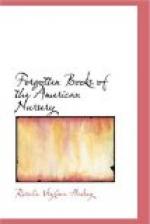After Newbery’s death, his son, Francis, and Carnan, his stepson, carried on the business until seventeen hundred and eighty-eight; from that year until eighteen hundred and two Edward Newbery (a nephew of the senior Newbery), who in seventeen hundred and sixty-seven had set up a rival establishment, continued to publish new editions of the same little works. Yet the credit of this experiment of printing juvenile stories belongs entirely to the older publisher. Through them he made a strong protest against the reading by children of the lax chap-book literature, so excellently described by Mr. John Ashton in “Chap-Books of the Eighteenth Century;” and although his stories occasionally alluded to disagreeable subjects or situations, these were unfortunately familiar to his small patrons.
The gay little covers of gilt or parti-colored paper in which this English publisher dressed his books expressed an evident purpose to afford pleasure, which was increased by the many illustrations that adorned the pages and added interest to the contents.
To the modern child, these books give no pleasure; but to those who love the history of children of the past, they are interesting for two reasons. In them is portrayed something of the life of eighteenth century children; and by them the century’s difference in point of view as to the constituents of a story-book can be gauged. Moreover, all Newbery’s publications are to be credited with a careful preparation that later stories sadly lacked. They were always written with a certain art; if the language was pompous, we remember Dr. Johnson; if the style was formal, its composition was correct; if the tales lacked ease in telling, it was only the starched etiquette of the day reduced to a printed page; and if they preached, they at least were seldom vulgar.
The preaching, moreover, was of different character from that of former times. Hitherto, the fear of the Lord had wholly occupied the author’s attention when he composed a book “proper for a child as soon as he can read;” now, material welfare was dwelt upon, and a good boy’s reward came to him when he was chosen the Lord Mayor of London. Good girls were not forgotten, and were assured that, like Goody Two-Shoes, they should attain a state of prosperity wherein
“Their Fortune and their Fame
would fix
And gallop in their Coach
and Six.”
Goody Two-Shoes, with her particular method of instilling the alphabet, and such books as “King Pippin” (a prodigy of learning) may be considered as tiny commentaries upon the years when Johnson reigned supreme in the realm of learning. These and many others emphasized not the effects of piety,—Cotton Mather’s forte,—but the benefits of learning; and hence the good boy was also one who at the age of five spelt “apple-pye” correctly and therefore eventually became a great man.
At the time of Newbery’s death it was more than evident that his experiment had succeeded, and children’s stories were a printed fact.




